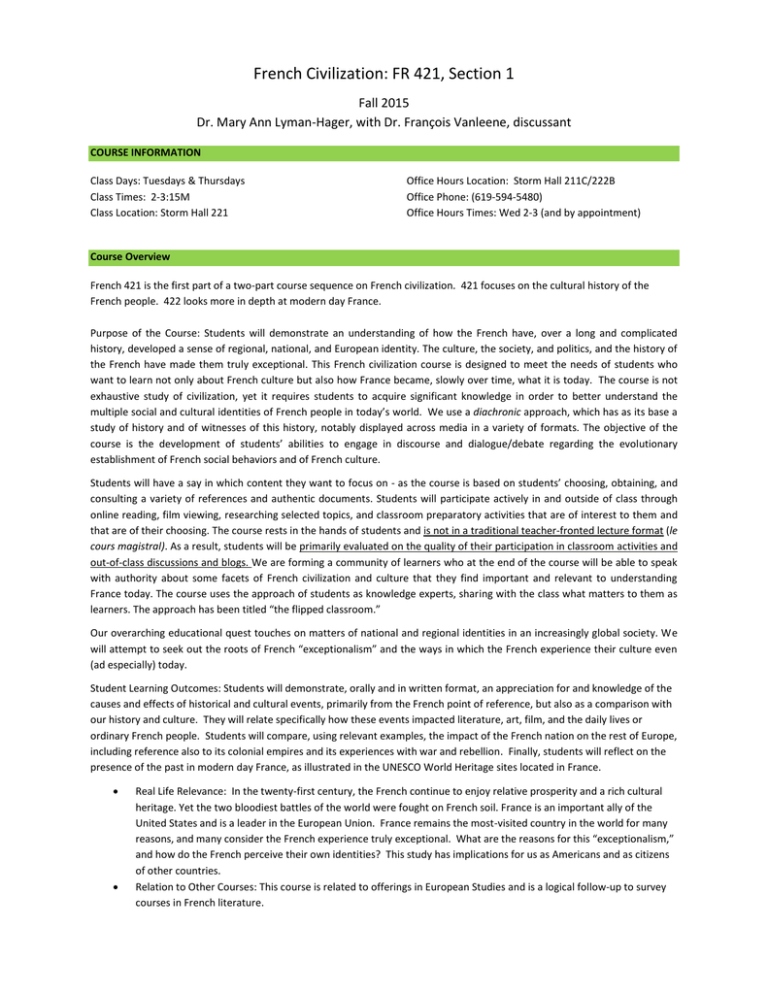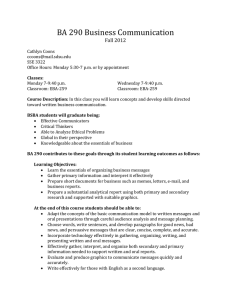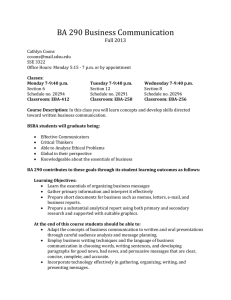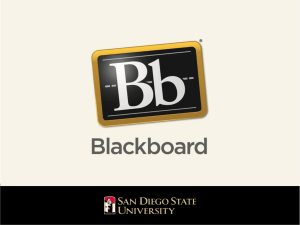French Civilization: FR 421, Section 1 Fall 2015
advertisement

French Civilization: FR 421, Section 1 Fall 2015 Dr. Mary Ann Lyman-Hager, with Dr. François Vanleene, discussant COURSE INFORMATION Class Days: Tuesdays & Thursdays Class Times: 2-3:15M Class Location: Storm Hall 221 Office Hours Location: Storm Hall 211C/222B Office Phone: (619-594-5480) Office Hours Times: Wed 2-3 (and by appointment) Course Overview French 421 is the first part of a two-part course sequence on French civilization. 421 focuses on the cultural history of the French people. 422 looks more in depth at modern day France. Purpose of the Course: Students will demonstrate an understanding of how the French have, over a long and complicated history, developed a sense of regional, national, and European identity. The culture, the society, and politics, and the history of the French have made them truly exceptional. This French civilization course is designed to meet the needs of students who want to learn not only about French culture but also how France became, slowly over time, what it is today. The course is not exhaustive study of civilization, yet it requires students to acquire significant knowledge in order to better understand the multiple social and cultural identities of French people in today’s world. We use a diachronic approach, which has as its base a study of history and of witnesses of this history, notably displayed across media in a variety of formats. The objective of the course is the development of students’ abilities to engage in discourse and dialogue/debate regarding the evolutionary establishment of French social behaviors and of French culture. Students will have a say in which content they want to focus on - as the course is based on students’ choosing, obtaining, and consulting a variety of references and authentic documents. Students will participate actively in and outside of class through online reading, film viewing, researching selected topics, and classroom preparatory activities that are of interest to them and that are of their choosing. The course rests in the hands of students and is not in a traditional teacher-fronted lecture format (le cours magistral). As a result, students will be primarily evaluated on the quality of their participation in classroom activities and out-of-class discussions and blogs. We are forming a community of learners who at the end of the course will be able to speak with authority about some facets of French civilization and culture that they find important and relevant to understanding France today. The course uses the approach of students as knowledge experts, sharing with the class what matters to them as learners. The approach has been titled “the flipped classroom.” Our overarching educational quest touches on matters of national and regional identities in an increasingly global society. We will attempt to seek out the roots of French “exceptionalism” and the ways in which the French experience their culture even (ad especially) today. Student Learning Outcomes: Students will demonstrate, orally and in written format, an appreciation for and knowledge of the causes and effects of historical and cultural events, primarily from the French point of reference, but also as a comparison with our history and culture. They will relate specifically how these events impacted literature, art, film, and the daily lives or ordinary French people. Students will compare, using relevant examples, the impact of the French nation on the rest of Europe, including reference also to its colonial empires and its experiences with war and rebellion. Finally, students will reflect on the presence of the past in modern day France, as illustrated in the UNESCO World Heritage sites located in France. Real Life Relevance: In the twenty-first century, the French continue to enjoy relative prosperity and a rich cultural heritage. Yet the two bloodiest battles of the world were fought on French soil. France is an important ally of the United States and is a leader in the European Union. France remains the most-visited country in the world for many reasons, and many consider the French experience truly exceptional. What are the reasons for this “exceptionalism,” and how do the French perceive their own identities? This study has implications for us as Americans and as citizens of other countries. Relation to Other Courses: This course is related to offerings in European Studies and is a logical follow-up to survey courses in French literature. Enrollment Information Course requirements and prerequisites include: Completion of 302 prior to enrollment. Please note the last day to drop, add, or change credit basis. It will be published on the SDSU website. Course Materials available Through the Bookstore or on BlackBoard 1. 2. 3. 4. Barreau, Jean-Claude. Toute l'Histoire de France. France: Éditions du Toucan, 2011. ISBN 978-2-25316293-3 (Required). Dérien, Marine. Les Sites Français Inscrits au Patrimoine de l'UNESCO. France: Éditions Belize, 2013. ISBN 978-2-917289-88-4. (Recommended) Optional Deutsch, Loränt. Métronome: L'Histoire de France au rythme du métro parisien. France: Éditions Michel Lafon, 2009. ISBN 978-2-226-25195-2. (Recommended) Optional Vanleene, François, and Mary Ann Lyman-Hager. La Civilisation Française. San Diego, CA: Montezuma Press, forthcoming. (This book is not required in print version, as it is available online, but if you want to print out the text, the version will be made available in print.) All audio-visual materials can be found on BlackBoard. Students may print out materials or may choose to order textbooks online or from the SDSU Bookstore. Please request captioning if you need this assistance. Accessibility of materials • All materials will be available in downloadable pdf format, in “docx” format on the BlackBoard course site, on Moodle, or on YouTube. Please request audio assistance if you need this feature to accompany your reading or viewing. Course Structure and Conduct Structure of the course is listed as lecture, but students will be very participatory and invited to also give “mini-lectures”: This is a lecture-discussion formatted class, with some online reflections and writing Individual and Group Activities Required (2 Blogs, 20 Short Individual or Group Class Presentations, 6 discussion forums) Points total 100. Technology utilized in the course: (Blackboard and Moodle, PowerPoint, YouTube, etc.) We are using Moodle 2.9. Please go to Course Assessment and Grading Your performance in this class will be assessed and graded according to the following deliverables: Bi-weekly oral assignments, “short talks,” delivered in class, on specific topics related to the week’s readings: 60% (3 points for each chapter covered in the online textbook (downloadable from Moodle or BlackBoard.) Total 60 points 2 blogs and 6 discussions (online): 38% + 2 in class comprehension checks (2 points) Total 40 points Absences are unexcused, except for extraordinary circumstances, such as illness or pre-approved professional purposes or religious observances. Make-up work, for those circumstances only, can be arranged with the instructor’s consent. Remember that when you are not in class, you cannot present, and you will automatically lose the 3 points for the chapter. Short in-class, spontaneous “knowledge checks” may be counted as extra credit. Up to 5 points may be added to your overall score based on the results of these. Accommodations The learning environment should be accessible to all. SDSU provides reasonable accommodations in the following situations: Disability: If you are a student with a disability and believe you will need accommodations for this class, it is your responsibility to contact Student Disability Services at (619) 594-6473. To avoid any delay in the receipt of your accommodations, you should contact Student Disability Services as soon as possible. Please note that accommodations are not retroactive, and that accommodations based upon disability cannot be provided until you have presented your instructor with an accommodation letter from Student Disability Services. Your cooperation is appreciated. Religion: By the end of the second week of classes, students should notify the instructors of affected courses of planned absences for religious observances. Official university activities (e.g., Athletics): Within the first two weeks of classes, a student who expects to be part of an official university event or activity shall notify the instructors of affected courses. At that time, the student shall request accommodation for any missed examinations or other assignments. If scheduling changes occur, the student shall immediately notify the instructors. Academic Honesty The University adheres to a strict policy regarding cheating and plagiarism. These activities will not be tolerated in this class. Become familiar with the policy (http://www.sa.sdsu.edu/srr/conduct1.html). Any cheating or plagiarism will result in failing this class and a disciplinary review by Student Affairs. Examples of Plagiarism include but are not limited to: Using sources verbatim or paraphrasing without giving proper attribution (this can include phrases, sentences, paragraphs and/or pages of work) Copying and pasting work from an online or offline source directly and calling it your own Using information you find from an online or offline source without giving the author credit Replacing words or phrases from another source and inserting your own words or phrases Submitting a piece of work you did for one class to another class If you have questions on what is plagiarism, please consult the policy (http://www.sa.sdsu.edu/srr/conduct1.html) and this helpful guide from the Library: (http://infodome.sdsu.edu/infolit/exploratorium/Standard_5/plagiarism.pdf) Cheating and Plagiarism Cheating and plagiarism are serious offenses. You are plagiarizing or cheating if you: for written work, copy down or cut anything from a book, article or website and add or paste it into your paper without using quotation marks and providing the full reference for the quotation, including page number for written work, summarize / paraphrase in your own words ideas you got from a book, article, or the web without providing the full reference for the source, including page number for an oral presentation, copy down or cut anything from a book, article, or website and present it orally as if it were your own words. You must summarize and paraphrase in your own words, and bring a list of references in case the professor asks to see it use visuals or graphs you got from a book, article, or website without providing the full reference for the picture or table recycle a paper you wrote for another class turn in the same (or a very similar paper) for two classes purchase or otherwise obtain a paper and turn it in as your own work copy off of a classmate use technology or smuggle in documents to obtain or check information in an exam situation In a research paper, it is always better to include too many references than not enough. When in doubt, always err on the side of caution. If you have too many references it might make your professor smile; if you don’t have enough you might be suspected of plagiarism. If you have any question or uncertainty about what is or is not cheating, it is your responsibility to ask your instructor. TAKE THE TUTORIAL: Test your knowledge of what constitutes plagiarism through a tutorial offered by the SDSU Library. To access the tutorial go to: http://library.sdsu.edu/guides/tutorial.php?id=28 Consequences of cheating and plagiarism SDSU instructors are mandated to report all instances of cheating and plagiarism to the Center for Student Rights and Responsibility. Consequences are at the instructor’s and the Center for Student Rights and Responsibility’s discretion. They may include any of the following: failing the assignment failing the class warning probation suspension expulsion For more detailed information, read the chapter on plagiarism in the MLA Handbook for Writers of Research Papers (6th edition, 2003), visit the following website http://www.indiana.edu/~wts/pamphlets/plagiarism.shtml and talk to your professors before turning in your paper or doing your oral presentation. The University of Indiana also has very helpful writing hints for students, including some on how to cite sources. Please visit http://www.indiana.edu/~wts/pamphlets.shtml for more information. Exams and Assignments 20 Class Presentations (for chapters 1-20). As there are significant numbers of chapters in the on-line textbook, we will employ the tactic of “partage” (sharing) to lighten the reading load. Each class period you will “report back” on an assigned reading or topic, which you will choose from a list in advance, showing what you have learned in a small talk of no more than 5-7 minutes. You may choose your language (French or English), depending on your source materials, but French is preferred. 2 Blogs (published on BlackBoard). Please follow MLA guidelines for citing references. These are “mini papers” which, taken together, may be revised to be included in the final paper, so the topics chosen for the blogs should optimally be related to one another. They will be written in French, with the exception of those citations that are written in English. 6 Discussions (published on BlackBoard,). Your writing AND responses to others will be considered in this activity. French is preferred for these discussions, again, unless you are citing from English language sources. The main purpose of the discussion board is to examine complex issues from several points of view, listing concrete justification for your stances. Syllabus (see the Detailed Syllabus in BlackBoard) CLASS SESSION TOPICS AND TEXTS Week 1 Intro to the course Chapter 0 – Visages of France Week 2 Chapter 1 - France before France Chapter 2 – The Antiquity of Gaul (Barreau: Gaulois et Romains, De -900 à 410, pp. 13-36) UNESCO sites 5, 7, 10, 11, 25, 15, 36, 37 Week 3 Chapter 3 – The Birth of France (Barreau: Une lente naissance, De 410 à 987, pp. 37-54) UNESCO sites 3, 12, 17, 29, 34 Week 4 Chapter 4 – Towards the unity of the French monarchy (Barreau: l’Apogée médiéval, De 987 à 1328, pp. 57-78) (Barreau: Naissance d’un patriotisme français, De 1328 à 1495, pp. 79-95) UNESCO sites 1, 2, 6, 8, 18, 19, 20, 22, 24 Week 5 Chapter 5 – Towards the Renaissance (Barreau: Une renaissance fastueuse et tragique, De 1495 à 1610, pp. 97-117) UNESCO sites 44 Chapter 6 – The Renaissance of wars UNESCO sites 24, 28, 31 CLASS SESSION TOPICS AND TEXTS Week 6 Chapter 7– Marching towards absolutism (Barreau : L’apogée classique ou les siècles français, De 1610 à 1789, pp. 121-147) UNESCO sites 9, 21 Week 7 Chapter 8 – Louis XIV, an absolute, divine-right monarch Film: TBA UNESCO sites 4, 32 Week 8 Chapter 9 – The monarchy under scrutiny Chapter 10- The sunset of France’s kings UNESCO sites 31, 16 Week 9 Chapter 11 – The bloody birth of the Republic – BLOG 1 Chapter 12 – The First Empire (Barreau: Une explosion fondatrice, De 1789 à 1815, pp. 151-179) UNESCO sites 13 Week 10 Chapter 13 – From the Restoration to the Second Empire Chapter 14 – The Establishment of the Republic (Barreau: Un siècle moderne, De 1815 à 1919, pp. 181-200) UNESCO sites 30, 33, 35 Week 11 Chapter 15 – The Great War (World War I) (Barreau: Un siècle moderne, De 1815 à 1919, pp. 201-217) UNESCO site 26, 38 Film : TBA Week 12 Chapter 16 – Between the two wars (Barreau: La course à l’abîme, De 1919 à 1940, pp. 219-237) Film : TBA Week 13 Chapter 17 – The Second World War (Barreau: L’honneur retrouvé, De 1940 à 1946, pp. 239-255) FILM : TBA Week 14 Chapter 18 – Post-war France, until 1969 Chapter 19 – The Republican pact and internationalism (Barreau, Reconstruction et mondialisation, De 1946 à 1990, pp. 257-271) Week 15 Chapter 20 - The sociocultural exceptionalism of France (Barreau: La France aujourd’hui et demain, De 1990 à 2008, pp. 273-281) Final Exam (BLOG 2) In Class Talks: Guidelines and Grading 3 points for each in-class talk (3=excellent to 0=not present). There are 20 chapters, so your total points for in-class talks totals 60 points, or 60% of your grade. Rubrics are used for grading on several attributes. The types of activities are listed below: Activity codes Activity description TED TALKS (T.T.) Classroom presentations on themes or on documents in a variety of formats. 5-7 minutes, with Q & A C.O. (Oral Comprehension) Oral comprehension of extracts (clips) of audio or film recordings. Each comprehension activity is led by a student who has chosen this activity. The student will select questions to present to the class following the comprehension activity. RÔLE Role play. One or several students will dramatically portray an important historical moment in time. Usually 2-3 students are involved in this activity. DÉBAT (Debates) Group discussions on themes proposed by the instructors. The debate is prepared by utilizing outside sources and is conducted in teams. COMPÉTITION Team “gamelike” competitions to assess knowledge acquisition and to verify understanding of the online textbook and research of associated topics. Usually the class is divided into 2-3 groups and each group asks questions of the other. SYNTHÈSE (SYN.) synthesis Formulation of short synopses on major topics designed to help students express themselves. This activity is particularly useful in preparing for discussions or blogs. PARTAGE (Sharing) Sharing of information among participants. Particularly with a long chapter, a group of students will work on a portion of the chapter and will share their portion with others during the class session for around ten minutes. Each class session will begin with this activity systematically. BLOGS DISCUSSIONS & FILM Writing activities contained in blogs and discussion forums. Blogs are individual efforts. Discussions involve the whole class online. Attention: Participants receive points based on the ONLINE CONVERSATIONS they engage in and their response to others’ postings. Non-participation results in 0 points. Participants watch film extracts (clips) in class and will be required to reconstruct the social and historical context of the film. This activity begins with a brief oral presentation and takes into account the fact that participants have previously read the chapter of the textbook pertaining to the topic. (See also C.O.) Each discussion forum is also graded on a 3-point scale (18 total possible points). There are 2 blogs due, one at mid-term and one at the final. Each are worth 10 points. Two in-class syntheses (written paragraphs) will also count for 2 points. Other spontaneous comprehension checks will count for extra credit. Additional Texts and Materials A textbook in PDF format, downloadable from the MOODLE or BLACKBOARD site and/or BlackBoard. Hard copies will be available from the campus bookstore. The final version of the book contains 21 chapters (including chapter 0, or the introduction.) Each chapter corresponds to the themes, organized by historical periods, which are featured in your syllabus (see the next page); Interactive presentations in HTML, accessible in each of the downloadable files, organized in the same structure as the online textbook. This format is being modified, and some materials are yet to be transferred to HTML format; PowerPoint/Articulate Storyline files corresponding to each chapter and containing a number of links ; Supplementary documents: audio files, video clips, images – available on MOODLE and/or BlackBoard A bibliography that you can consult for research purposes – available on MOODLE and/or BlackBoard Enrolling in MOODLE To enroll on the LARC Moodle 2.9 site: 1. 2. 3. 4. Go to the following URL: http://larcmoodle.sdsu.edu/ Create a MOODLE account following the instructions in English Click on: French Language and Culture / Online French Civilization Course Enter the enrollment key: FrenchCiv15


